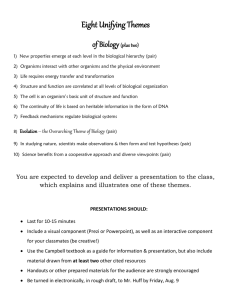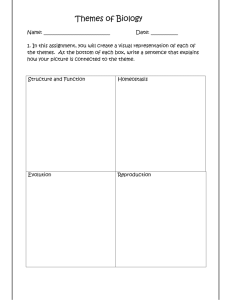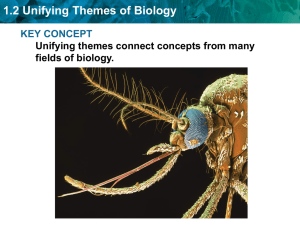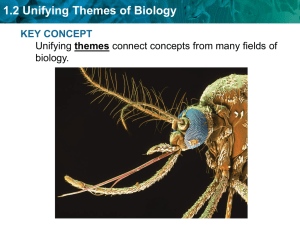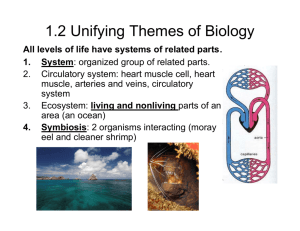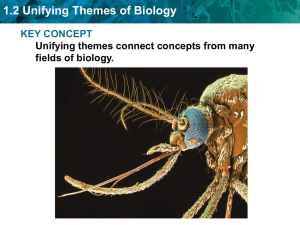1.2 Unifying Themes of Biology
advertisement
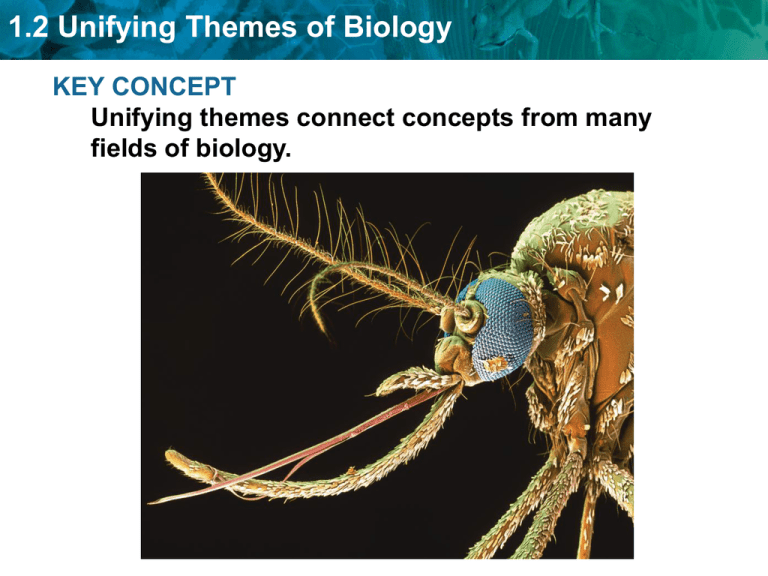
1.2 Unifying Themes of Biology KEY CONCEPT Unifying themes connect concepts from many fields of biology. 1.2 Unifying Themes of Biology I. All levels of life have systems of related parts. A. A system is an organized group of interacting parts. 1. A cell is a system of chemicals and processes. 2. A body system includes organs that interact. 3. An ecosystem includes living and nonliving things that interact. 1.2 Unifying Themes of Biology B. Biologists study many different systems. 1.2 Unifying Themes of Biology II. Structure and function are related in biology. A. Structure- refers to what something looks like or how it is made B. Function- refers to the way something works or what it does 1.2 Unifying Themes of Biology C. Structure determines function. 1. Proteins with different structures perform different functions. 2. Heart muscle cells have a different structure and function than stomach muscle cells. 3. Different species have different anatomical structures with different functions. 1.2 Unifying Themes of Biology III. Organisms must maintain homeostasis to survive in diverse environments. A. Homeostasis is the maintenance of constant internal conditions. 1. example- sweating, shivering, blood sugar 1.2 Unifying Themes of Biology B. Behaviors and adaptations can help maintain homeostasis. 1.2 Unifying Themes of Biology IV. Evolution explains the unity and diversity of life. A. Evolution is the change in living things over time. 1. The genetic makeup of a population of a species changes. 2. Evolution can occur through natural selection of adaptations. 3. Adaptations are beneficial inherited traits that are passed to future generations. 1.2 Unifying Themes of Biology B. Evolution accounts for both the diversity and the unity of life. 1.2 Unifying Themes of Biology What are the four themes of biology? • • • • Systems Structure and Function Homeostasis Evolution 13.1 Ecologists Study Relationships For each of the following descriptions, indentify which theme of biology is being described. 13.1 Ecologists Study Relationships A wolf has sharp teeth for catching prey. 13.1 Ecologists Study Relationships Over time, the colors of this species of moth have changed, and it now blends in very nicely to the leaves of a tree. 13.1 Ecologists Study Relationships When a person eats a lot of sugar, their body produces insulin to maintain the body’s blood sugar level. 13.1 Ecologists Study Relationships These fish interact with one another and with the algae, insects, water and sunlight that are in the river. 13.1 Ecologists Relationships These leavesStudy are really big so that they can capture a lot of sunlight. 13.1 Relationships AllEcologists of these Study organs work together to break down food and absorb energy. 13.1 Ecologists Study Relationships This dog is panting to keep itself cool. 13.1 Ecologists Relationships These cacti Study a very good at conserving water, an adaptation that allows them to live in very hot places.
